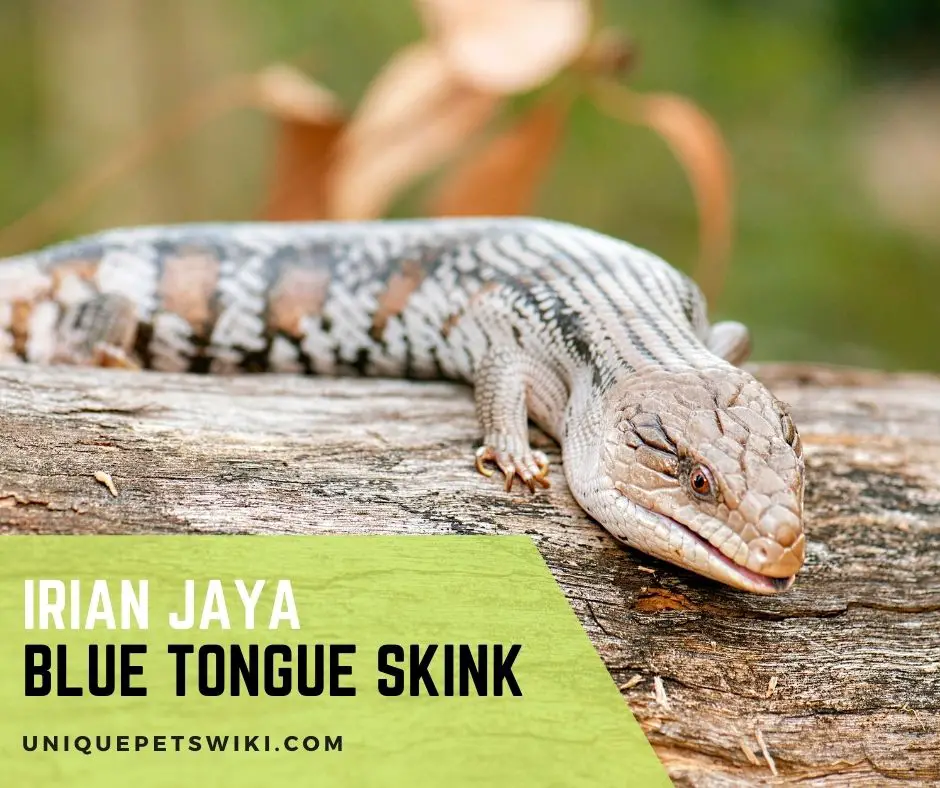The Irian Jaya is a widely misunderstood species that is frequently the subject of debate. Irian Jayas are considered the oddballs of blue-tongue skinks because their taxonomy is still lacking.
This article will give you all the information you need about the Irian Jaya blue tongue skink.
Contents
Irian Jaya Blue Tongue Skink Overview
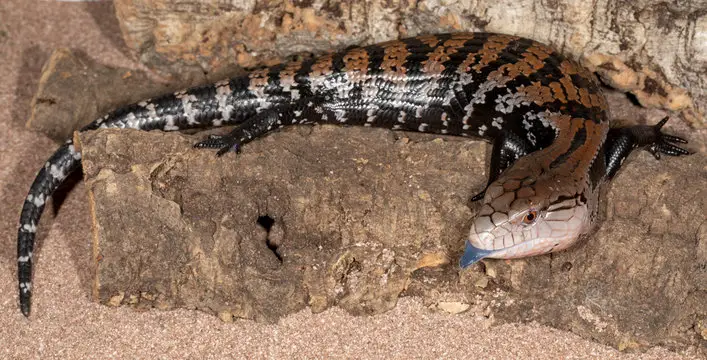
The Irian Jaya has a pattern that is distinct and considered to be one of the most attractive among blue-tongued skinks.
The Irian Jaya, like the other species, has a huge blue tongue that it uses defensively in times of distress or danger. An adult’s entire length is around 15-30 inches.
The Irian Jaya has not yet been formally identified, in terms of etymology, although it appears to be a distinct species from the other known members of the genus.
| Common Name | Irian Jaya Blue Tongue Skink |
| Scientific Name | Tiliqua scincoides / Tiliqua sp. |
| Average Size | 15-30 inches |
| Life expectancy | 15-30 years |
| Availability | Quite rare availability |
| Habitat | Dry tropical regions |
| Basic diet | Omnivorous diet; carrion, small invertebrates, and greens |
Origin And Appearance
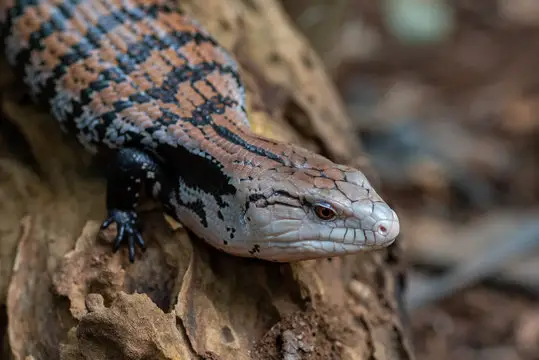
The discovery of the Irian Jaya blue-tongue skink was in the early 1990s. However, they are still insufficiently identified and described at present. There is still only little known about its origin.
Irian Jayas are a gorgeous species that is simple to find and has a very friendly demeanor. They often grow to be 18-22 inches tall and have 5-15 offspring depending on their size.
Another intriguing fact is that when Irian Jaya is bred with another species, the offspring nearly invariably look like Irian Jaya which supports the natural hybridization theory.
Offspring are extremely adorable, with unnaturally large heads. The colors are varied, with different hues of browns, oranges, and reds interlaced into wonderfully linked and broken bands.
Their bellies are frequently bright red but can range from cream to orange to crimson.
Aside from the Western, several Irian Jayan species have the potential to be the most gorgeously colored skinks due to their wide range of color variations.
The usual colors of their broad stripes are dark brown or black with a peachy gold to brown undertone.
Gender Differences And Mating
In terms of gender differences, females are typically longer than males. Males often have bigger and wider skulls, however, this is not always the case.
If the head is broader than the body, it is most certainly a male.
The breeding season happens only once a year. When a male finds a skink that is ready to mate, he marks her with a scent and followers her around.
Mating may be violent, with males biting the female’s sides to keep her down.
Scale damage and minor bleeding are typical. Blue-tongued skinks are normally solitary creatures that only congregate during the breeding season.
Irian Jaya is an ovoviviparous island. Their gestation cycle is around 100 days, and they have 5 to 15 babies every litter.
The newborns resemble the adults almost identically, with just minor color differences. Just a few days after birth, the infants will venture out on their own and begin eating tiny insects and fruits.
Irian Jaya skinks should be physically separated if maintained as pets, and any young should be watched for overall health throughout their first few shedding.
They should only be considered for sale or trade after many weeks of good development and nutrition.
Irian Jaya Blue Tongue Skink Care Sheet
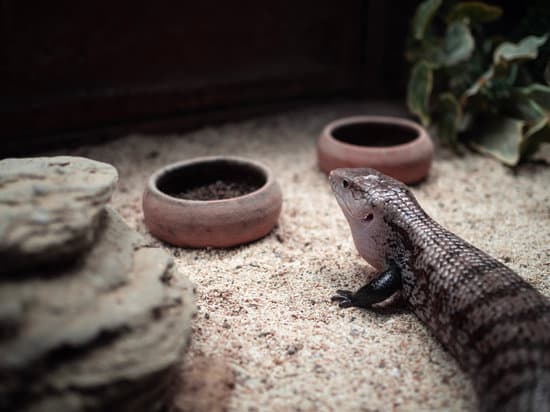
Blue-tongue skinks are a diurnal, terrestrial lizard found in Australia and portions of Indonesia.
They can grow to be 24″ long and have a lifetime of 15-20 years, yet with proper care, they can live to be 30. Blue-tongue skinks require slightly varied care depending on the species.
Enclosure For Irian Jaya Blue Tongue Skink
Properly and adequately caring for an Irian Jaya blue-tongue skink includes providing ample space and a clean enclosure for it to live in. Below are the essential considerations for setting up its new habitat.
Tank/Vivarium
Blue-tongue skinks are large lizards that develop fast, therefore even for a baby, the minimum suggested enclosure size is 4’x2’x2′, or 8 sq ft of floor area or 75 to 120 gallons.
The ideal types are terrariums or aquariums with full-screen tops.
Blue-tongue skinks are very active physically. Thus, you should prepare and obtain a large habitat with adequate space if you can. Choose an enclosure that opens from the front rather than the top.
PVC is considered the best material for a blue tongue skink enclosure because of its waterproof and lightweight features. Glass or well-sealed wood are other good materials.
No more than one blue tongue skink should be housed in a single cage.
Housing blue tongue skinks together will most certainly stress them greatly, increasing the likelihood of their fighting and injuring themselves badly.
Check out: Best Blue Tongue Skink Enclosure For Building The Correct Habitat!
Substrate
As burrowing lizards, blue-tongue skinks require 4 to 6 inches of deep, soft, loose ground. Use soft substrates such as coconut husk, cypress mulch, and reptile soil.
However, the sort of substrate required is determined by the type of skink. Dry substrates are required for Australian species, whereas humid substrates are required for Indonesian species.
To function correctly, bioactive substrates require a clean-up crew (CUC) of helpful bugs. You will need pretty big cultures of tropical springtails and isopods like powder blues, powder oranges, and dwarf purples at the absolute least.
Allow your bioactive substrate and any live plants to settle for approximately a month before introducing your blue tongue skink for the best effects.
Also read: TOP 10 Best Blue Tongue Skink Substrate For Bedding
Light and Heat
Blue-tongue skinks are diurnal – only active during the day. And, being reptiles, they require UVB illumination in their surroundings to promote health and wellness.
UVB radiation is used by reptiles to produce vitamin D, improve their immune systems, and trigger the creation of endorphins. UVB also aids in the elimination of infections in the cage.
Because heat and UVB go hand in hand, the bulb and fixture should cover half of the enclosure and be located on the same side as the heat lamp.
You will also need a LED grow light for the plants if you are putting together an enclosure. This is also advantageous to the skink, so it’s a win-win situation!
Blue-tongue skinks are cold-blooded so they require external heat to function correctly. They are generally more comfortable with an overhead heat source.
Because they are cold-blooded, they require a temperature gradient to allow them to warm up and cool down in their enclosure. Here are appropriate temperatures:
- Basking surface for Northerns — 105-115°F
- Others — 100-105°F
- Cool side: 70-80°F
- Nighttime: No lower than 65°F
Also read: Best Lights For Blue Tongue Skinks
Humidity
Blue-tongue skinks require precise degrees of humidity in their surroundings for optimal health, and it is 60-80%.
To improve humidity, just spray water into the cage with a spray bottle. In comparison to other substrate alternatives, bioactive substrates are great at maintaining humidity.
Humidity will naturally be increased on the cool side of the enclosure than on the warm side, thus you may track the humidity levels in your skink’s habitat with a digital thermometer or hygrometer with the probe set on the cool side.
Basking Accessories
Most blue-tongue skinks do not bask for lengthy periods on rocks, platforms, branches, and hides or shelters.
Most blue-tongue skinks do well in optimal conditions, and as long as they are warm, they will properly digest food and poop.
However, you can still consider some of the following accessories:
- Basking rock or a platform, hides
- Plants and foliage.
- Branches, logs or other accessories to clamber on.
- Water dish.
- Food bowl.
Zilla Shale Rock Den One size
- Rock formations that appear realistic inside the terrarium
- Satisfy your pet's desire to find a place to hide and cool down
- Provides and elevated platform for your pet to bask and warm up
- Non-porous exterior resists bacterial growth
- Easy to clean with warm, soapy water and rinse
Last update on 2022-12-29 / Affiliate links / Images from Amazon Product Advertising API
Dishes and Bowls
Blue-tongue skinks should always have easy access to a large, sturdy water dish. Providing big water bowls will help them maintain their humidity as they drink water often, although they rarely soak.
Diet Of Irian Jaya Blue Tongue Skink: What Should I Feed Them?
Blue-tongued skinks are omnivores. Their meals must consist of 40% protein, 50% vegetables, and 10% fruit, and must be served once up to thrice every week.
Protein
Their diet must be 40% protein. Your blue-tongued skink may consume crickets, calcium worms such as Black Soldier Fly larvae, morios, locusts, silkworms, dendrobaena (earthworms), roaches, and snails. Green beans, prickly pear, and mulberry leaf are also excellent protein sources.
You must duplicate the requirement for nutritional variety inside the confined diet. In turn, feed as many healthy insect choices as possible, along with vegetables and dietary supplements for nutritional variety.
Veggies and Fruit
Blue-tongued skinks enjoy eating squash such as butternut, acorn, summer, spaghetti, and hubbard.
Occasionally, you can also serve broccoli, Brussel sprouts, bell pepper, carrots, cauliflower, celery, cucumber, parsnips, sweet potato, spring greens, pumpkin, and turnip.
Fruit is an important element of the blue-tongued skink’s natural diet.
However, it is usually of the berry kind – blueberries, blackberries, raspberries, and strawberries are excellent choices for this portion of the diet.
Feeding a banana, apple, pear, or melon as a reward is a fantastic way to provide diversity and balance.
These, however, should be maintained to a minimum. Citrus, such as lemon or orange, should not be fed to reptiles since it might induce gastrointestinal issues.
Healthy Herp Instant Meal Veggie Mix
Water
Blue-tongue skinks should always have access to fresh water, which should be replaced regularly.
Depending on the lizard’s age, size, and species, it can go on without eating for up to two months. However, they cannot live without water for more than a few days.
Dietary Supplements
You may lightly sprinkle the meal with a calcium carbonate supplement (without phosphorus or vitamin D) right before serving it to your pet skink.
Calcium supplements should have calcium: phosphorous ratio of at least 2:1. Vitamin D-containing products should be avoided since they can cause toxicity.
Behavior Of Irian Jaya Blue Tongue Skink
Blue-tongue skinks are becoming increasingly popular in the reptile world. They are sociable and have wonderful personalities.
They appear to like being noticed and can develop strong attachments to their owners. Their behavior when doing specific activities are discussed below.
Temperament
Blue-tongue skinks are normally a peaceful, gentle species that are not easily stressed.
They are readily handled by people of various ages and levels of expertise. They’re a decent size to pick up, and they’re quite easy to sustain on their own body.
Handling and Bonding
While many reptiles dislike being touched and others accept it, blue-tongued skinks are quite friendly and frequently appear to like being caressed on the head or chin. They appear to like the spotlight.
Begin with handling in a quiet area, but gradually add other noises, other people, and environments.
Interact daily to hasten taming and bonding. It might take months for some blue-tongues to become more comfortable. Some may be rather fiery.
Also read: Do Blue Tongue Skinks Like To Be Handled?
Shedding
The skin of blue-tongue lizards is shed. During this season, they may scratch themselves like a dog.
It may be a difficult period for them, especially young ones who shed their skin more frequently as they develop.
Young blue-tongue skinks under 12 months old may shed every 2-3 weeks, whereas blue tongues 12-18 months old may shed once a month.
Adult blue-tongue skinks (18 months and older) are shed once every 2-3 months.
Bathing/basking
A medium or big-sized water basin should always be included in the skink enclosure for backup.
You may observe the skink using it for washing; this is normally done to chill itself or relax its shedding skin.
Skinks enjoy bathing in their water, but they also frequently defecate in it, thus the water dish must be cleaned regularly.
Blue-tongued skinks naturally spend a lot of time basking in the sun. They like doing it. As a result, they demand a warm basking environment of 100 degrees Fahrenheit during the day.
Also read: Best Basking Spot for a Blue Tongue Skink
Brumation
A blue tongue skink will sleep almost continually and eat or drink nothing during brumation.
They will occasionally emerge out of hiding, roam about for a while, and then go back to sleep. It is very uncommon for your skink to be missing for weeks at a time or even to look dead when brumating.
How Much Does Irian Jaya Blue Tongue Skink Cost?
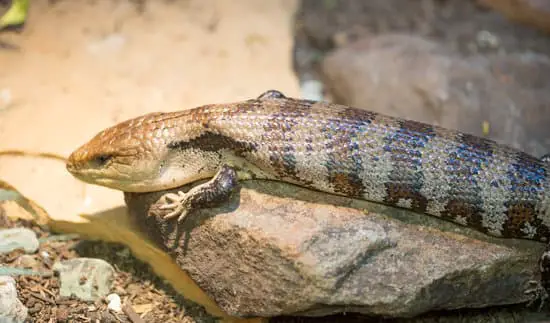
Adult blue-tongue skinks are more expensive than baby blue-tongue skinks. Lineage is charged at the same rate. Blue-tongue skinks are often priced at $150 or higher.
Less common species, like the Hypo Merauke variant, will set you back $5000 or more. They belong to some of the most elusive ones. They range from $250 to $400 which depends on the availability.
The starting price for blue tongue skinks is also determined by their gender. Female blue-tongue skinks are often more expensive than male blue tongue skinks.
Blue-tongue skink upkeep costs roughly $40 per month for one species.
Where Can You Buy An Irian Jaya Blue Tongue Skink
The Blue-Tongued Skink may be found in Australia, New Guinea, and Tasmania. They are most typically seen in semi-desert habitats with burrows.
They also dwell in grasslands and scrublands, where they hide under leaf litter or logs. They can be purchased in pet stores, from breeders, classified advertisements or Facebook groups, and reptile rescue.
Cost Of Keeping Irian Jaya Blue Tongue Skink
For the setup of the tank, the enclosure itself can cost $100-$500. You must provide a large water dish which is $20, tank decorations, and caves that are around $30.
When your blue tongue skink is a newborn, it will most likely need to eat twice a day, six days a week.
Adults, on the other hand, only require feeding three times each week. A ballpark figure for your blue tongue skink’s food bill is $50 per month.
If your blue-tongue skink is healthy, monthly health care should be inexpensive. You also would not have to buy new healthcare supplies every month.
Fun Facts About Irian Jaya Blue Tongue Skink
- In the wild or even in captivity, the bulk of the day is spent by blue-tongued skinks looking for food and basking in the sun. They seek cover among logs, leaf litter, and other ground debris at night.
- The blue-tongue skink puffs up its body, puts out its long, blue tongue, and hisses when threatened. If the targeted victim is not impressed, the wide-bodied skink hisses and flattens its body in the hopes of seeming too enormous to assault.
- Blue-tongues can bite hard but their teeth are not well- or fully developed. They also have a propensity of not letting go, which adds significantly to the discomfort.
- The overlapping scales of the skink help keep dirt, sand, and other material out. Every six weeks, healthy individuals shed their skin. Shedding consumes a significant quantity of energy, lowering typical meal metabolism significantly.
- The overlapping scales of the skink help keep dirt, sand, and other material out.
Are Irian Jaya Blue Tongue Skink Good Pets?
Blue Tongue Skinks are normally a peaceful, gentle species that are not easily stressed. They are readily handled by people of various ages and levels of expertise.
Skinks are low-maintenance pets. They are suitable for beginners, children and also those who are scouting for pets to own.
Some skinks demand a specialized diet, so you may have to spend some time gathering the necessary meals for them.
It will be difficult to cope with an aggressive lizard type. You must also use caution when cleaning your surroundings.
If your pet skink escapes or becomes separated from you, it will never return and will most likely perish in the wild. Most lizards require time to become accustomed to being caressed, and there is a potential that it will bite.
Because they can transmit Salmonella germs, you must exercise caution when disposing of its excrement and handling your skink.
Some skinks, particularly large ones, cannot coexist with other pets and can be dangerous to little children.
Conclusion
The Irian Jaya blue-tongue skink is one of those skink species with the least level of information.
It has not yet been formally defined, yet it is distinct from the other members of the genus. They can make great pets, even for beginners.
Hope this article was helpful in thoroughly discussing the basic information on Irian Jayas!
